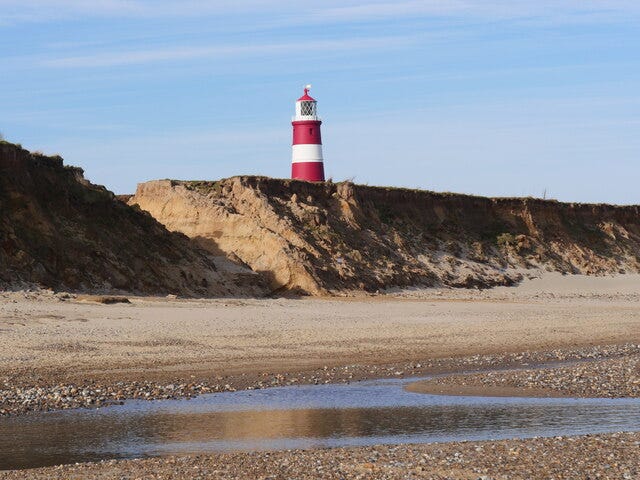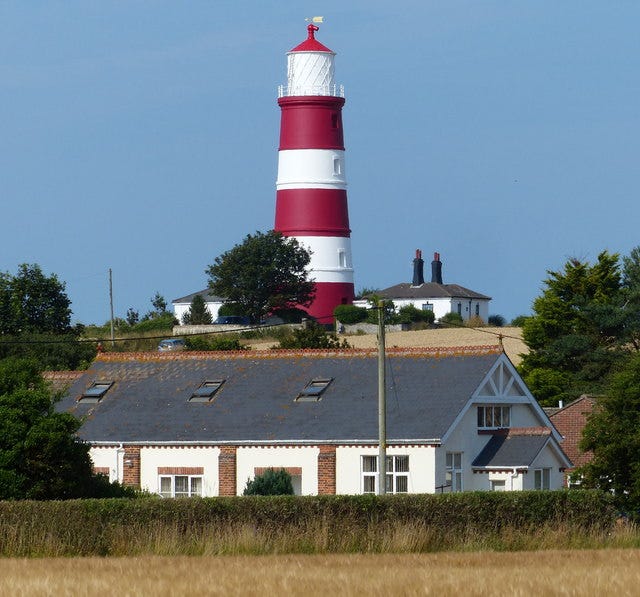Happisburgh’s Lighthouse. You really couldn’t miss it! (Colin Park/geograph)
Nestled on the ever picturesque Norfolk coast, Happisburgh Lighthouse is a beacon of both light and history. As the oldest working lighthouse in East Anglia and the only independently operated lighthouse in the UK, it stands as a testament to resilience, community spirit, and maritime heritage.
And amazing engineering!
Erected in 1790, Happisburgh Lighthouse was one of a pair of lighthouses built to guide vessels through treacherous coastal waters. While its partner, the Low Light, succumbed to demolition in the nineteenth century, the High Light—Happisburgh Lighthouse—has shone brightly for over two centuries.
Its distinctive red and white stripes, painted in 1871, make it instantly recognisable and iconic, serving not only as a navigational aid but also as a cherished landmark.
The lighthouse’s story is intertwined with the community’s commitment to preserving it.
In 1987, Happisburgh Lighthouse faced potential decommissioning as part of a cost-cutting initiative. However, the residents of Happisburgh rallied together, forming the Happisburgh Lighthouse Trust. Their tireless efforts ensured that the lighthouse was saved, becoming the first privately owned operational lighthouse in the UK. Today, the trust—composed largely of volunteers—continues to maintain and operate the lighthouse, embodying a sense of collective pride and determination.
Close to the edge. Will the North Sea claim the lighthouse one day? (David Pashley/geograph)
Happisburgh’s maritime heritage is as rich as its coastal scenery is striking. Perched on cliffs that reveal a history of geological change, the lighthouse overlooks an area that has seen centuries of shipwrecks, trade, and fishing. Its beam, reaching eighteen miles out to sea, has been a lifeline for countless sailors navigating the North Sea’s unpredictable conditions.
The lighthouse also represents the fragility of its environment. Coastal erosion is a pressing issue for Happisburgh, with the cliffs retreating dramatically over recent decades. The lighthouse’s survival is a poignant reminder of the need to balance conservation with progress.
Visitors to Happisburgh Lighthouse are greeted not just with stunning views but also with an invitation to delve into its history. Open days, run by the trust, offer a chance to climb the spiral staircase and step into the lantern room, where the Fresnel lens stands as a masterpiece of engineering. From here, the vistas stretch across the Norfolk countryside and out to sea, a view that has inspired artists, photographers, and writers alike.
Happisburgh’s lantern is 134 feet above sea level-making it stand out for miles around (Matt Fascione/geograph)
The lighthouse has also become a symbol of hope and continuity. In an era of rapid change, its steadfast beam is a reassuring constant. It’s a reminder that even in the face of challenges—whether they be economic, environmental, or societal—communities can come together to protect and celebrate their heritage.
Happisburgh Lighthouse isn’t just a navigational aid; it’s a story of endurance, adaptability, and connection. Whether you’re drawn by its historical significance, its architectural charm, or the breathtaking coastal views, a visit to Happisburgh Lighthouse offers a glimpse into the past while, and sorry but I like metaphors, shining a light on the future. It’s a must-visit for anyone exploring Norfolk, a place where history meets the horizon, and the spirit of the community truly shines.
I’d recommend a visit-as well as enjoying yourself on the day, you will, forever afterwards, be able to tell people that you’ve ‘seen the light’…
…and meant it!






